![]()
Chinese tech company Beaverlab Technology Co., Ltd has taken Kickstarter by storm with its Excope DT1 camera. However, the camera is suspicious at best and an outright lie at worst.
The camera, which promises to “capture beyond the horizon with your smartphone,” has shattered its modest $20,000 funding goal. At the time of writing, it had just eclipsed $372,000 in support, and it is rapidly increasing by the hour. There are still 57 days left in the campaign, which has earned Kickstarter’s “Project We Love” sticker, adding more legitimacy to the Excope DT1.
By the way, the project is listed as from Boulder, Colorado on Kickstarter, but Beaverlab is based in Shenzhen, per LinkedIn. It’s just something worth mentioning.
Impossible Promises
Before considering what the Excope DT1 might achieve in reality, let’s see what Beaverlab says it can do. The Excope DT1 promises 200 times magnification, a 400mm focal length, a 48-megapixel image sensor, and “super computing power.” Controlled wirelessly using a connected smartphone — not included, of course — the Excope DT1 includes “cutting-edge optics and advanced digital technology with an ultra-telephoto lens.”
Given the 48-megapixel sensor’s size (1/1.8-inch), the 400mm lens is not an actual 400mm lens but a shorter lens with a heavy crop factor. That’s not wildly misleading, as smartphone companies do that sort of thing all the time. The 24mm primary camera lens on an iPhone 15 Pro is a 6.8mm lens with a 3.5 times crop factor to account for the image sensor size.
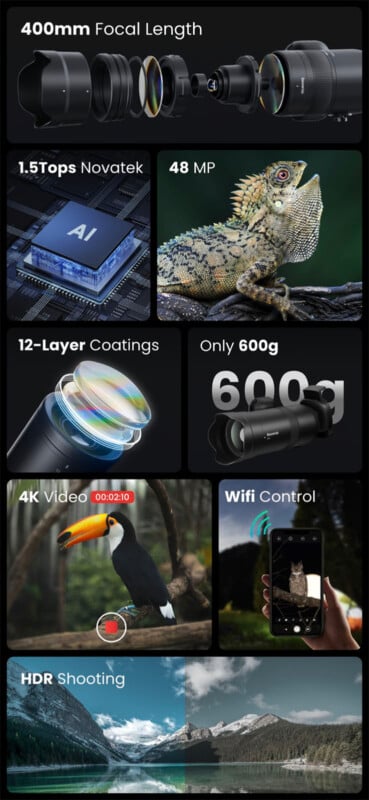
If that were the only suspicious thing about the Excope DT1 campaign, that wouldn’t be bad. That’s a standard way to talk about lenses with small image sensors on cameras.
If only things were so simple.
![]()
Are the Photos Deceptive?
When a company sells a camera, photos in the official marketing materials can reasonably be expected to have been shot using that camera. In the case of the Excope DT1, a product that promises high-quality telephoto images, there would be no apparent reason for the average Kickstarter user’s hackles to be raised when looking at beautiful sample shots of animals. The page certainly doesn’t say anything to suggest that the photos aren’t genuine.
However, something can seem off for photographers. Can a Type 1/1.8-inch sensor, smaller than many modern smartphone image sensors, capture photos that look this sharp and deliver this sort of bokeh? No.
However, seasoned vets with dedicated camera gear aren’t the campaign’s expected target audience. The goal is to sell a product using false promises to people who don’t know better.
Given how most Kickstarter campaigns, the Excope DT1’s included, put photos in larger graphics, there is no way to pull individual frames from the page and start digging into the data. So, PetaPixel asked Beaverlab for some original sample files.
“When you say ‘samples,’ are you referring to pictures taken through our device,” Artak Mkrtichyan, the public relations manager for the Excope DT1 campaign, confirmed.
“Correct,” PetaPixel replied.
After a short delay, the company obliged, sending two still photos and a pair of video files under the guise that, like all the samples on the Kickstarter page, these files were captured using the Excope DT1.
The ‘Sample Photos’ Are Not From the Excope DT1
The two .JPG files are of primary interest, as they are nice photos of an Iberian lynx and a kingfisher in the wild. If someone liked wildlife and wanted an affordable way to capture great images, why wouldn’t they be interested in something like the Excope DT1?
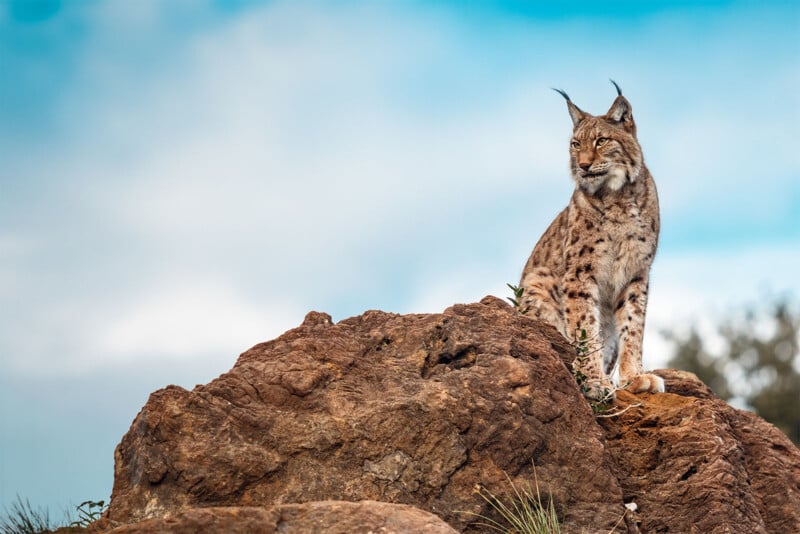
Looking first at the Iberian lynx file, which is a 5,472 x 3,648 .JPG image, something is not quite right. It isn’t a 48-megapixel file, it is a 19.9-megapixel image, which also rules out the possibility of a pixel-binned 16-megapixel image capture — a common technique used on smaller image sensors to improve low-light performance.
It also doesn’t have the appearance of an image shot with a small image sensor. There is a reason that smartphone companies use digital trickery to get soft, out-of-focus backgrounds. It is exceptionally challenging, if not physically impossible, to get the “big camera” look from a small image sensor without artificial bokeh.
To be fair, Beaverlab says that it uses “real-time image processing” and “intelligent background defocus.” However, to admit that there is digital manipulation at play while showing photos that have background defocus because of actual optics is deceptive.
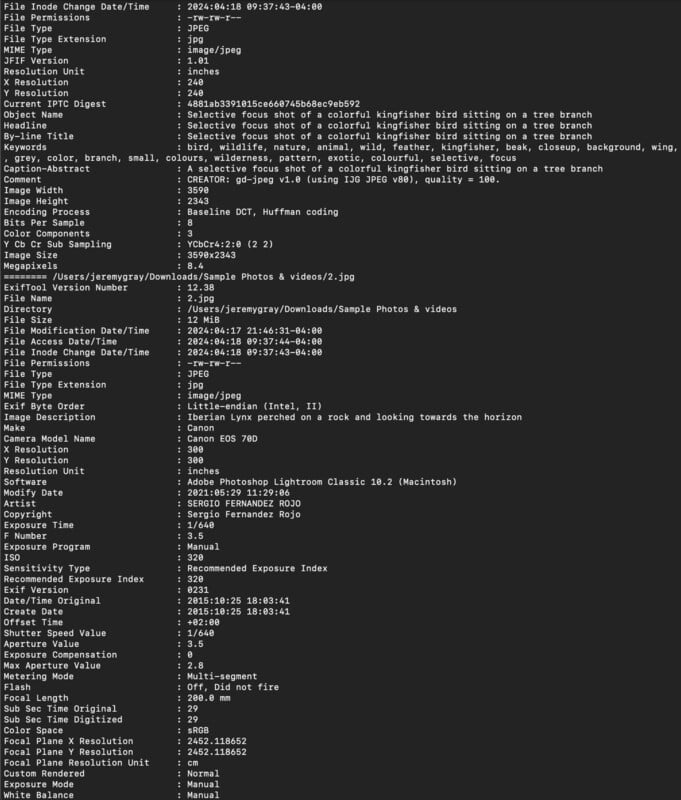
A quick look in ExifTool shows that the lynx photo doesn’t look like it was captured with a diminutive image sensor because, well, it wasn’t. It was shot using a Canon EOS 70D DSLR. Despite its “small” APS-C sensor, it is still an interchangeable lens camera capable of professional image quality, and most importantly, it is not the Excope DT1.
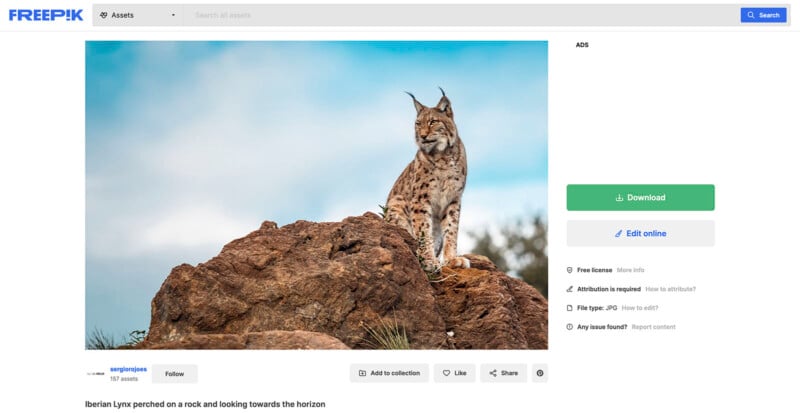
Since Beaverlab ignored the attribution requirement listed on the photo’s page on Freepik.com, a stock image site, PetaPixel will tell you that it was shot by Sergio Rojo.
For those curious, Rojo took the photo on October 25, 2015, in manual exposure mode with a 1/640s shutter speed, f/3.5 aperture, and ISO 320. His lens was an EF 70-200mm f/2.8L USM at 200mm.
So, the lynx image was not shot with the Excope DT1; what about the Kingfisher photo? That image file, which is a paltry 8.4 megapixels, lacks metadata. It still has embedded keywords, though. A quick Google search brings up Deposit Photos, PetaPixel‘s go-to source for stock images. When we use them, we label them as such, but alas.
Huh, the “XL” version of the kingfisher photo, offered by Wirestock, is the same size as the file Beaverlab Technology emailed. This wasn’t shot using the Excope DT1, either.
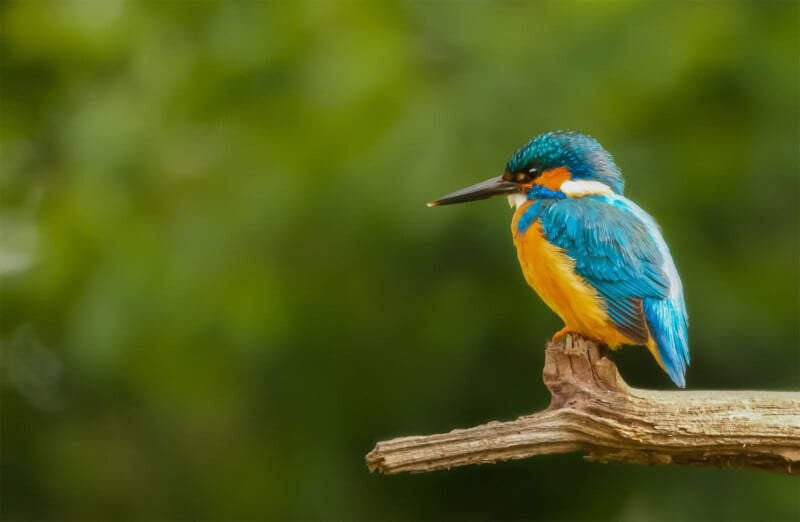
If these are the images the company sends when specifically asked to send sample images shot with the camera, there is no reason to believe any of the other photos on the Kickstarter page were legitimately shot with the Excope DT1.
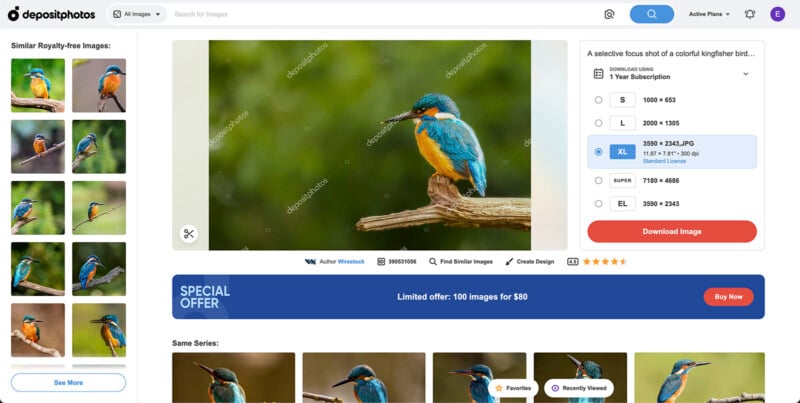
However, there are plenty of reasons to be skeptical. Consider the DT1 Night Mode “sample” below. That level of low-light performance from a sensor that size is, frankly, unbelievable.
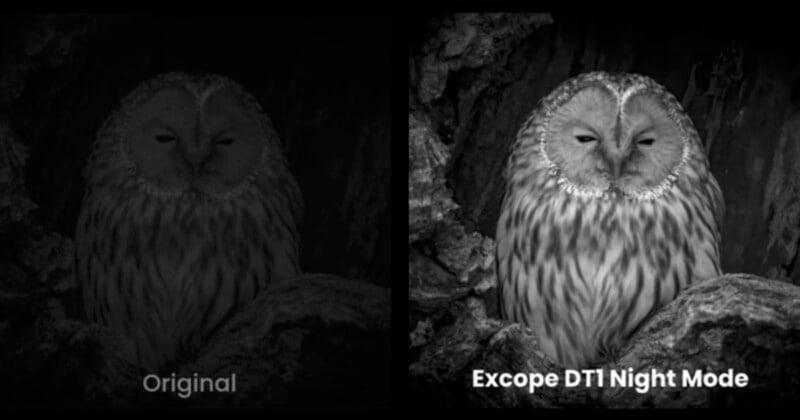
There were many ways for Beaverlab Tech to avoid this situation. Instead of using deceptive photographs, the company could have said upfront that sample images were illustrative and not captured using the DT1.
If a company sells a camera and includes sample photos, everyone will reasonably think the included photos were shot using the offered camera. Why would anyone think otherwise?
At least when Kenko Tokina used stock photos on a camera product page, the company said the images weren’t indicative of what the camera could capture.
The Excope DT1 Exists, Even if the Legitimacy of Most Sample Photos Are Questionable
If the camera hadn’t been manufactured yet, that would be reasonable. That said, given that it has a video review of the camera on the Kickstarter page, at least one working sample must be floating around.
YouTube channel HansTechTalk has an “honest review” of the Excope DT1, which has garnered 18,000 views and some plaudits in the comments.
A highlight from the “review” includes out-of-focus footage of a bird in a birdbath playing, while Hans says that the 400mm lens enables users to capture footage of dangerous wildlife safely. Oh, and this footage? It’s also seen on the Kickstarter page.
Some of the sample images in the video do at least seem real; they look like they were shot with a small image sensor.
The video ends with Hans casually saying that if the Excope DT1 were two times more expensive than it is, it would still be worth it. That’s funny because the camera, available to backers now for $199, will have an MSRP of $399. Huh, a review says the camera is worth precisely what its maker says it will cost at retail.
Beaverlab also shared a video that shows the DT1 used to capture close-ups of the Moon. This sample seems plausible.
The Issue With Misleading Photos
If getting more real sample images wasn’t possible, why not use labeled illustrative examples that are at least realistic representations of what customers can expect from the Excope DT1? Photos from smartphones or small-sensor superzoom cameras would be reasonable stand-ins for a presale campaign. It’s not ideal, but it’s better than what is available now.
For $199, even so-so imaging performance could still be worth it for people looking to affordably document wildlife or take photos of the Moon. The Excope DT1 is not necessarily a bad product; it’s just that the camera’s actual results will not match what people are shown on Kickstarter. People are being sold an impossible promise.
![]()
More than 1,600 people have given Beaverlab their money. The sample images are doing a lot of work in the campaign because who wouldn’t want photos like that using their phone and a $200 camera accessory? It’s an exciting proposition.
It’s too bad that it’s impossible, despite what Beaverlab claims, all while taking people’s money.
PetaPixel has requested comment and genuine Excope DT1 sample photos. At the time of publication, Beaverlab has not responded.
Image credits: Beaverlab / Sergio Rojo / Wirestock
